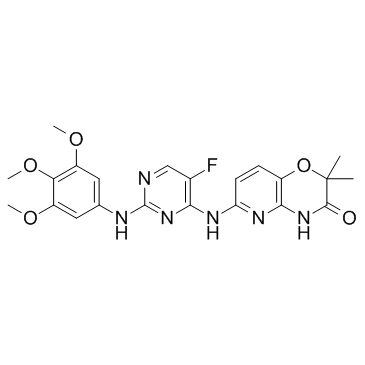841290-80-0
| Name | 6-[[5-fluoro-2-(3,4,5-trimethoxyanilino)pyrimidin-4-yl]amino]-2,2-dimethyl-4H-pyrido[3,2-b][1,4]oxazin-3-one |
|---|---|
| Synonyms |
N-Aminocytidine
uridine,4-hydrazone 6-({5-Fluoro-2-[(3,4,5-trimethoxyphenyl)amino]-4-pyrimidinyl}amino)-2,2-dimethyl-2H-pyrido[3,2-b][1,4]oxazin-3(4H)-one N4-aminocytidine minimum N4-NH2-Cr 6-({5-Fluoro-2-[(3,4,5-trimethoxyphenyl)amino]pyrimidin-4-yl}amino)-2,2-dimethyl-2H-pyrido[3,2-b][1,4]oxazin-3(4H)-one compound 1007 R406 R-406 |
| Description | R406 is a potent Syk inhibitor with IC50 of 41 nM, strongly inhibits Syk but not Lyn, 5-fold less potent to Flt3. IC50 value: 41 nM [1]Target: Syk in vitro: R406 is a potent inhibitor of immunoglobulin E (IgE)- and IgG-mediated activation of Fc receptor signaling. R406 inhibits the anti-IgE-induced production and release of LTC4 and cytokines and chemokines, including TNFα, IL-8, and GM-CSF. R406 inhibits phosphorylation of Syk substrate linker for activation of T cells in mast cells and B-cell linker protein/SLP65 in B cells. R406 binds to the ATP binding pocket of Syk and inhibits its kinase activity as an ATP-competitive inhibitor with Ki of 30 nM. R406 blocks Syk-dependent FcR-mediated activation of monocytes/macrophages and neutrophils and Bcr-mediated activation of B lymphocytes [1]. R406 significantly induces chronic lymphocytic leukemia (CLL) cell apoptosis in nurselike cells cocultures and blocks CCL3 and CCL4 secretion by CLL cells in response to B-cell antigen receptor (Bcr) triggering [2]. R406 is a potent inhibitor of platelet signaling and functions initiated by FcγRIIA cross-linking by specific antibodies or by sera from HIT patients [3].in vivo: R406 reduces cutaneous reverse passive Arthus reaction by approximately 86% at 5 mg/kg in prophylactic treated mice. R406 also shows efficacy in inhibiting paw inflammation in antibody-induced arthritis mouse models [1]. R406 does not adversely affect macrophage or neutrophil function in innate immune responses and has minimal functional immunotoxicity notwithstanding its lymphocytopenic effect [4]. |
|---|---|
| Related Catalog | |
| References |
| Density | 1.4±0.1 g/cm3 |
|---|---|
| Molecular Formula | C22H23FN6O5 |
| Molecular Weight | 470.454 |
| Exact Mass | 470.171387 |
| PSA | 128.75000 |
| LogP | 4.32 |
| Index of Refraction | 1.618 |
| Storage condition | -20°C |
